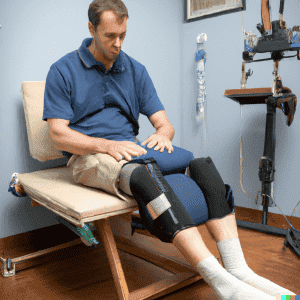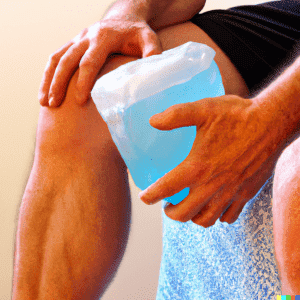Table of Contents
Can you imagine the wind in your hair as you glide down the pavement on a pair of roller skates? It’s a feeling of freedom and exhilaration that many of us enjoy. But what if you’ve recently had knee replacement surgery?
Does that mean you have to bid farewell to your beloved skates forever? Not so fast, my friend! In this article, we’re going to delve into the fascinating world of skating after knee replacement surgery.
We’ll take a closer look at the amazing benefits of skating, weigh the risks involved, and most importantly, discover the secrets to skating safely and comfortably with your brand-new knee.
So, whether you’re a seasoned skater or a novice hitting the pavement for the first time, hang tight and keep reading. We’ve got some valuable tips on how to keep rolling after knee replacement surgery.
Apusale Bike Skateboard Helmet, Adjustable and Multi-sport for Skate Scooter, 3 Sizes for Adult Youth Kids Toddler
$29.99 (as of 07/03/2024 12:37 GMT +01:00 - More infoProduct prices and availability are accurate as of the date/time indicated and are subject to change. Any price and availability information displayed on [relevant Amazon Site(s), as applicable] at the time of purchase will apply to the purchase of this product.)Symptoms of a need for knee replacement
Imagine this: you’re going about your day, but there’s a nagging pain in your knee that just won’t quit. It’s like having an unwelcome guest who refuses to leave. You try resting, you try medication, but nothing seems to bring relief.
If this sounds familiar, my friend, it might be time to consider a knee replacement. But how do you know if it’s the right choice for you? Well, there are a few telltale signs to watch out for.
Are you experiencing chronic knee pain and stiffness that seems to stick around no matter what?
That could be a red flag. And if your knee joint is protesting every time you try to move it, with a limited range of motion that feels like a stubborn door that won’t fully open, it’s worth paying attention to.
Walking or standing for long periods has become a real challenge, and you’re hearing strange grinding or popping sounds when you bend your knee.
Yes, these are all signs that a knee replacement might be on the horizon. And hey, if you notice any swelling, tenderness, or a visually deformed knee, don’t wait around – get yourself to a healthcare professional pronto!
They’ll help you figure out what’s causing your knee troubles and guide you toward the best treatment plan.
SULIFEEL Kids Adjustable Quad Roller Skates,Toddler Beginner Roller Skates for Girls and Boys Age 2-5 Years Old
$29.99 (as of 07/03/2024 12:37 GMT +01:00 - More infoProduct prices and availability are accurate as of the date/time indicated and are subject to change. Any price and availability information displayed on [relevant Amazon Site(s), as applicable] at the time of purchase will apply to the purchase of this product.)Exercise to carry out after knee surgery

Let’s talk about what happens after knee surgery. Picture this: you’re fresh out of the operating room, and now it’s time to get your knee back in tip-top shape.
One of the key players in your recovery journey is physical therapy. Yup, it’s exercise time!
But don’t worry, it’s not as intimidating as it sounds. Your trusty physical therapist will be right there by your side, creating a personalized exercise program just for you.
So, what kind of exercises can you expect? Let me give you the lowdown on a few common ones. First up, we’ve got the quadriceps setting. You’ll lie on your back, with a cosy little pillow under your operated knee.
Slowly tighten those thigh muscles and hold for a count of 5. Repeat this gem 10 times. Easy peasy, right?
Next on the list is the hamstring curls. Now, flip onto your stomach (pillow still under your knee, of course) and slowly curl that leg up towards your buttocks.
Hold it there for 5 seconds, then gracefully lower it back down. Repeat this beauty 10 times.
And then there are heel slides. Back to lying on your back, pillow in place. Gently straighten your leg and slide that heel along the floor until your leg is nice and straight.
Hold it there for 5 seconds, then slowly bend your knee back to the starting position. Do this golden move 10 times.
Last but not least, we’ve got the side-lying leg raises. Roll onto your side, with your head resting on a heavenly pillow. Now, raise that operated leg up, hold for 5 seconds, and gracefully lower it back down. You guessed it – repeat this gem 10 times.
Now, remember to take it easy and listen to your physical therapist’s advice. They’re the experts, after all. Start off nice and slow with these exercises, and as you get stronger, you can increase the repetitions and sets.
And hey, if you have any questions or concerns along the way, don’t hesitate to have a heart-to-heart with your physical therapist. They’re there to help you make the best possible progress in your recovery.
OutdoorMaster Skateboard Cycling Helmet-Beetles Snug,Bike Helmet for Adults, Youth & Kids-Two Removable Liners Ventilation Multi-Sport Commuter Scooter Roller Skate Inline Skating Longboard
$19.99 (as of 07/03/2024 12:37 GMT +01:00 - More infoProduct prices and availability are accurate as of the date/time indicated and are subject to change. Any price and availability information displayed on [relevant Amazon Site(s), as applicable] at the time of purchase will apply to the purchase of this product.)How knee replacement surgery may affect your roller skating
If you’ve recently had knee replacement surgery, I’m here to give you the lowdown on when you can lace up those skates again. But hold your horses, my friend, because this is important stuff.
You absolutely must wait until your surgeon gives you the green light. No ifs, or buts about it.
See, roller skating puts quite a bit of stress on those precious knees of yours, and that’s not what you want right after surgery. So be patient and give your incisions time to heal up.
Wait until you have the full range of motion before even thinking about stepping onto those wheels.
Once your surgeon gives you the thumbs up, it’s time to take it slow and steady. Start with short skating sessions and gradually increase the duration and intensity as your body allows.
And here’s the golden rule: listen to your body. If you start experiencing any pain or swelling in that operated knee of yours, stop skating immediately and consult with your doctor.
Remember, my friend, your surgeon’s instructions are like the holy grail. Follow them to a T to avoid any further damage to your knee. They know what’s best for you.
Now, let’s talk about something important. Roller skating after knee replacement surgery isn’t for everyone. You heard me right. It’s crucial to consult with your doctor to see if roller skating is the right fit for you.
They’ll take into consideration your specific situation and give you personalized advice.
Oh, and here’s an interesting tidbit: some research suggests that patients who have had knee replacement surgery should avoid high-impact activities like running or jumping for at least a year post-surgery.
Many patients have reported positive feedback from skating soon after surgery. Some physiotherapists have even recommended it to improve range of motion and strength.
But let me emphasize this again: have a heart-to-heart with your doctor before you strap on those skates. They’ll give you the final word on whether roller skating is a go or a no-go for your knee.
And remember, your health and recovery always come first. Take care of yourself and follow your doctor’s advice. Now go out there and roll with caution!
WayEee Kids Bike Helmet Set Skateboard Knee Pads, Helmet Pad Set Protective Gear Set Adjustable for Girls Kids 3-10 Helmet Elbow Pads Wrist Guards for Sport Cycling Bike Roller Skating Scooter
$26.99 (as of 07/03/2024 12:37 GMT +01:00 - More infoProduct prices and availability are accurate as of the date/time indicated and are subject to change. Any price and availability information displayed on [relevant Amazon Site(s), as applicable] at the time of purchase will apply to the purchase of this product.)What it is like to roller skate after surgery
I know you’re itching to get back on those wheels, but let’s talk about taking it slow after surgery. See, when you’ve been through the hospital experience, your muscles and joints can be a little weak and out of shape.
Start with short skating sessions. Don’t go all out right from the get-go. Gradually increase the length and intensity of your skating as your muscles and joints regain strength. It’s like dipping your toes into the water before diving in headfirst.
But hold up, I want you to do something super important. And that is… drumroll… check with your doctor! Yep, it’s always a good idea to get the green light from your doctor before starting any new exercise routine.
They know your specific situation best and will give you the go-ahead or provide any necessary precautions.
Roller skating can still be a fantastic way to get back into shape after surgery. It’s all about being cautious and mindful of your body.
So put on that brace or support sleeve on your operated knee. This nifty little accessory will help prevent pain and inflammation, giving your knee the extra support it needs.
Wearing a knee brace or support sleeve is crucial because your knee cap is held in place by ligaments and tendons that can be easily damaged during surgery.
By using that brace or support sleeve, you’re keeping your knee cap secure and reducing the risk of further injury.
So, remember to take it slow, check with your doctor, wear that brace or support sleeve, and get some guidance from a physical therapist.
With a little caution and care, you’ll be back to enjoying the freedom and fun of roller skating in no time. Keep that positive attitude and roll on!
Adult Knee Pads Elbow Pads Wrist Guards for Adult Kids 6 in 1 Protective Gear Set for Skateboarding Biking Roller Skating Cycling Outdoor Sports Black L
$19.99 (as of 07/03/2024 12:37 GMT +01:00 - More infoProduct prices and availability are accurate as of the date/time indicated and are subject to change. Any price and availability information displayed on [relevant Amazon Site(s), as applicable] at the time of purchase will apply to the purchase of this product.)Take breaks often to rest your knee and allow it to cool down.
When it comes to taking care of your knees, a physical therapist is your go-to superhero. They’re like the wise sage who will guide you on how often to take breaks and what activities to avoid.
Now, depending on how much time you spend on your feet or if you have a brand-new knee, you may need to take more breaks.
Your physical therapist will be the one to shed light on this and help you figure out the perfect balance. So, don’t hesitate to pick their brain and get all the advice you need.
But here’s the golden rule: take regular breaks throughout the day. It’s like pressing that pause button and giving your knee a well-deserved breather.
By doing this, you’ll not only reduce the amount of pain you’re experiencing but also allow your knee to cool down. Trust me, your knees will thank you for it.
And pay extra attention if you have arthritis or other conditions that cause inflammation. Regular breaks become even more crucial in these cases.
It’s all about giving your knees some TLC and keeping that inflammation in check.
So, remember to lean on your physical therapist for guidance. They’ll help you navigate the world of breaks, exercises, and knee care.
Together, you’ll find the perfect rhythm that keeps your knees happy and healthy. Trust the process, and let’s give those knees the love they deserve!
Ugboiu Roller Skates for Men and Women, Black Derby Roller Skates with 4 Shiny Wheel, Classic Double-Row Roller Skates for Indoor and Outdoor
$39.59 (as of 07/03/2024 12:37 GMT +01:00 - More infoProduct prices and availability are accurate as of the date/time indicated and are subject to change. Any price and availability information displayed on [relevant Amazon Site(s), as applicable] at the time of purchase will apply to the purchase of this product.)Be aware that you may not be able to roller skate as long or as fast as you could before surgery.
Let’s talk about the joy and thrill of gliding on those wheels after surgery. Roller skating is a fantastic activity that people of all ages can enjoy, and the best part is that it’s low-impact.
But here’s the thing: after surgery, your body may have gone through some changes, and it’s essential to be mindful of that when you hit the rink.
Now, don’t get discouraged. You might not be able to skate as long or as fast as you could before surgery, and that’s perfectly okay. It’s all part of the healing process.
You might find that starting and stopping is a bit more challenging, and you might get tired more quickly. But fear not! With a little practice and patience, you’ll be back in the skating game, safe and sound.
The secret sauce here is listening to your body and taking things at your own pace. Your body knows best, my friend. If you start feeling fatigued, take a break and catch your breath.
Enjoy the scenery, chat with fellow skaters, or simply take a moment to soak in the excitement around you. By doing this, you’ll ensure a safer and more enjoyable skating experience.
Remember, this is your unique journey. Embrace the changes, respect your body’s limits, and celebrate every milestone along the way. With time and practice, you’ll find your skating groove once again.
Triple Eight Saver Series Pad Set with Kneesavers, Elbowsavers and Wristsavers
$32.25 (as of 07/03/2024 12:37 GMT +01:00 - More infoProduct prices and availability are accurate as of the date/time indicated and are subject to change. Any price and availability information displayed on [relevant Amazon Site(s), as applicable] at the time of purchase will apply to the purchase of this product.)Consult with your doctor before starting any new physical activity after surgery.
Now, knee replacement surgery is a common procedure that works wonders in relieving pain and improving mobility for folks with knee joint damage.
But before you strap on those sneakers and dive into a new physical activity, there’s an important step you must take: consult with your doctor.
You might also find yourself in the wonderful hands of a physiotherapist. They’re like magical trainers who will help you develop an exercise program that suits your needs perfectly. These professionals know their stuff, so embrace their guidance with open arms.
By following your doctor’s advice and the expertise of the physiotherapist, you’ll be able to minimize those risks and maximize the incredible benefits of knee replacement surgery. It’s all about finding the right balance.
Together, you’ll embark on a journey of healing, recovery, and regaining that mobility you’ve been dreaming of.
So, remember to consult with your doctor, listen to their recommendations, and consider the expertise of a physiotherapist. With their support and your dedication, you’ll be back in the game, enjoying the wonders of physical activity after knee replacement surgery.
Stay positive, stay motivated, and get ready to embrace a new chapter of movement and freedom!
80Six Dual Certified Kids Bike, Scooter, and Skateboard Helmet, Designed by Industry Leading Brand Triple 8
$21.99 (as of 07/03/2024 12:37 GMT +01:00 - More infoProduct prices and availability are accurate as of the date/time indicated and are subject to change. Any price and availability information displayed on [relevant Amazon Site(s), as applicable] at the time of purchase will apply to the purchase of this product.)Cautions from the medical profession
It is important to follow your doctor’s orders and recommendations after a knee replacement surgery.

Let’s dive into the world of knee replacement surgery and the crucial role of post-operative care. Brace yourself, because this major operation comes with a demanding rehabilitation process.
But with a little dedication, you can pave the way for a successful outcome.
The key to unlocking that success lies in following your consultant orthopaedic surgeon’s orders and recommendations to a T.
And speaking of comfort, ice and elevation will be your trusty companions in reducing swelling. Embrace them, my friend.
Ice those knees and give them a well-deserved lift. It’s a simple yet powerful way to aid your healing process.
By faithfully adhering to your surgeon’s advice and recommendations, you’re giving yourself the best shot at a full and speedy recovery. You’ve got this, my friend! Keep that positive mindset, follow the plan, and watch as your knee gets stronger day by day.
Remember, knee replacement surgery is a journey. It may be challenging at times, but with determination, patience, and the expert guidance of your surgeon, you’ll come out on top.
Retrospec Retrospec Dakota Bike Helmet - Skateboard Helmet Premium Protection Multi-Sport Bike, BMX, Skating, Scooter, and Skate Helmet
$26.99 (as of 07/03/2024 12:37 GMT +01:00 - More infoProduct prices and availability are accurate as of the date/time indicated and are subject to change. Any price and availability information displayed on [relevant Amazon Site(s), as applicable] at the time of purchase will apply to the purchase of this product.)It is important to listen to your body and take it easy in the weeks and months following surgery.
Let’s talk about the importance of giving yourself some tender loving care after surgery. Your body has been through quite a journey, and it deserves some well-deserved rest and recovery time.
Depending on the type of surgery you had, you may find yourself spending a few days or even weeks in the hospital. That’s your body’s way of saying, “Hey, I need some extra attention here!”
So, embrace that hospital stay and let the healthcare professionals take care of you.
Once you’re back home, it’s time to continue the self-care journey. Take it easy, my friend. This is not the time to tackle strenuous activities.
Your body is in the process of healing and needs some gentle treatment. So, resist the urge to jump into high-intensity workouts or heavy lifting. Your body will thank you for it.
But hey, taking it easy doesn’t mean neglecting yourself. In fact, it’s quite the opposite! It’s the perfect opportunity to nourish your body with healthy, nutritious food and plenty of fluids.
Think of it as giving your body the building blocks it needs to rebuild and come back even stronger.
And here’s the golden rule: listen to your body. It’s the best guide you have on this recovery journey. If it’s telling you to rest, take a break and relax.
If it’s telling you to move around gently, go for a short stroll. Trust those signals and give your body the time and space it needs to heal.
KAMUGO Kids Adjustable Helmet, Suitable for Toddler Kids Ages 2-14 Boys Girls, Multi-Sport Safety Cycling Skating Scooter Helmet
$28.98 (as of 07/03/2024 12:37 GMT +01:00 - More infoProduct prices and availability are accurate as of the date/time indicated and are subject to change. Any price and availability information displayed on [relevant Amazon Site(s), as applicable] at the time of purchase will apply to the purchase of this product.)In Conclusion
Let’s wrap up our discussion on the exciting topic of skating after knee replacement surgery. The good news is, knee replacement surgery doesn’t have to mean the end of your skating adventures.
You can still lace up those skates and hit the pavement with some modifications and precautions.
Skating is a fantastic way to stay active, enjoy the great outdoors, and feel that exhilarating sense of freedom as you glide along. And guess what? You can still experience all of that even after knee replacement surgery.
It’s all about making some adjustments and taking care of yourself.
Throughout this article, we’ve explored the benefits of skating and the potential risks involved after knee replacement surgery.
But fear not, my friend, because we’ve also provided you with some handy tips and techniques to ensure you can skate safely and comfortably.
By following these guidelines and listening to your body, you’ll be reducing the risk of injury and maximizing your enjoyment on those wheels. It’s all about finding the right balance, my friend.
So, whether you’re a seasoned skater with a passion for gliding or a beginner just starting out, don’t let knee replacement surgery hold you back.
Take the time to dive into the full article, soak up all the knowledge and guidance we’ve provided, and learn how to skate safely and comfortably after your surgery.
Remember, it’s all about taking care of yourself, understanding your limitations, and making the necessary adjustments.
With a little bit of patience and a lot of determination, you can keep rolling and continue to experience the joy and freedom of skating after knee replacement surgery.
CHICAGO Skates Premium Black Quad Roller Skates for Boys and Men Beginners Classic Adjustable High-Top Design for Indoor or Outdoor Skates and Roller Derby
$54.99 (as of 07/03/2024 12:37 GMT +01:00 - More infoProduct prices and availability are accurate as of the date/time indicated and are subject to change. Any price and availability information displayed on [relevant Amazon Site(s), as applicable] at the time of purchase will apply to the purchase of this product.)Are Jam Skates or Rhythm Skates Better for Roller Skating with Knee Replacements?
When considering roller skating with knee replacements, it’s important to understand the differences in jam skates versus rhythm skates. Jam skates excel in agility and fluid movements, making them suitable for intricate footwork.
On the other hand, rhythm skates prioritize stability and ease of control, which can be beneficial for those concerned about knee strain. Ultimately, the choice depends on personal preferences and the specific needs of the individual.
FAQ’s
How long does it take to recover from a replacement knee?
The average recovery time from knee replacement surgery is approximately six months, but it can take roughly 12 months to fully return to physically demanding activities.
What is the best age to have a knee replacement?
Generally speaking, the best age for knee replacement surgery is between 70 and 80 years of age.
How painful is having a knee replacement?
Having a knee replacement is not typically a very painful procedure. Most patients report a dull ache during the recovery process, and it can take several weeks for the pain to completely go away.












